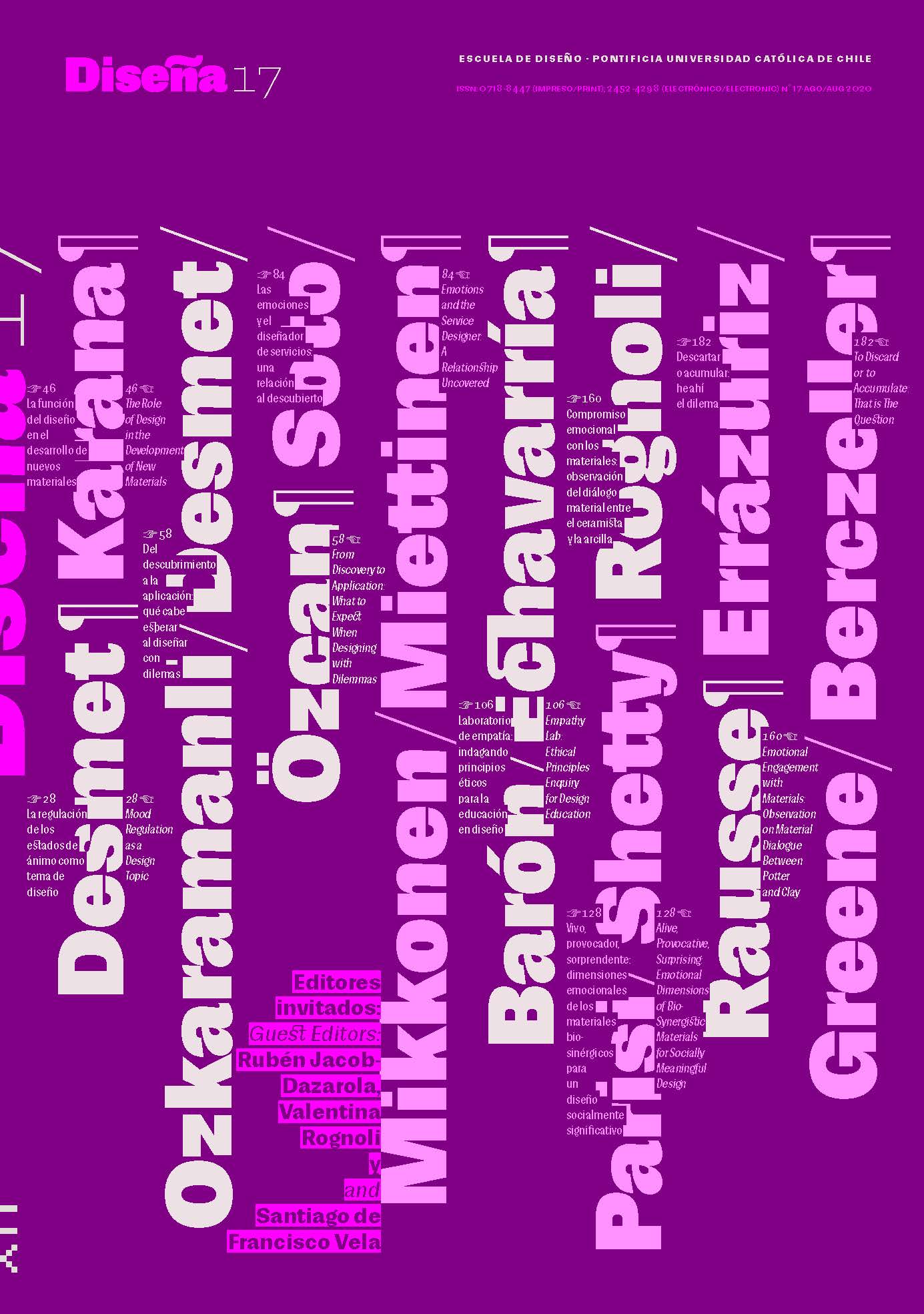La regulación de los estados de ánimo como tema de diseño: entrevista con Pieter Desmet
Contenido principal del artículo
Resumen
Pieter Desmet es codirector y cofundador del Delft Institute of Positive Design, chair del TU Delft Department of Human Centered Design y Director de los Delft Design Labs. Después de introducir la teoría cognitiva de las emociones en el campo de la investigación en diseño, estableció la Design and Emotion Society. Profesor titular de Diseño para la Experiencia en la TU Delft, Desmet es coeditor de Design and Emotion Moves (Cambridge Scholars, 2008) y coautor de Positive Design: An Introduction to Design for Subjective Well-Being (IJDesign, 2013). Doctor en el campo de la Psicología de la Emoción, Pieter Desmet acaba de recibir una beca personal de cinco años para investigar los matices que presenta el estado de ánimo de las personas en sus interacciones con los productos. Además de sus actividades académicas, Desmet también contribuye a proyectos comunitarios, entre los que destacan el recientemente desarrollado parque vecinal de bienestar sensorial y la “Casa de la Felicidad” cultural ubicada en Róterdam. En esta entrevista, Desmet analiza los antecedentes del diseño positivo, así como los desafíos prácticos y éticos que surgen al utilizar dicho enfoque. También se refiere a su línea de investigación más reciente: el diseño para la regulación de los estados de ánimo. Finalmente, Desmet explica cómo transfiere a las empresas el conocimiento que desarrolla.
Descargas
Detalles del artículo

Este obra está bajo una licencia de Creative Commons Reconocimiento-CompartirIgual 4.0 Internacional.
NOTA DE COPYRIGHT
Todos los contenidos de esta edición electrónica se distribuyen bajo licencia Creative Commons de “Atribución-Copartirigual 4.0 Internacional” (CC-BY-SA). Cualquier reproducción total o parcial del material deberá citar su procedencia.
Los derechos de las imágenes publicadas pertenecen a sus autores, quienes otorgan a Diseña la licencia para su uso. La gestión de los permisos y la autorización de publicación de las imágenes (o de cualquier material) que contenga derechos de autor y sus consecuentes derechos de reproducción en esta publicación es de exclusiva responsabilidad de los autores de los artículos.
Citas
COOPER, A. (1999). The Inmates Are Running the Asylum: Why High-Tech Products Drive Us Crazy and How to Restore the Sanity. Macmillan.
DESMET, P. M. A., XUE, H., & FOKKINGA, S. F. (2019). The Same Person Is Never the Same: Introducing Mood-Stimulated Thought/Action Tendencies for User-Centered Design. She Ji: The Journal of Design, Economics, and Innovation, 5(3), 167–187. https://doi.org/10.1016/j.sheji.2019.07.001
DUNNE, A. (1999). Hertzian Tales: Electronic Products, Aesthetic Experience, and Critical Design. MIT Press.
FRIJDA, N. H. (1986). The Emotions. Cambridge University Press.
GAVER, B., DUNNE, T., & PACENTI, E. (1999). Design: Cultural Probes. Interactions, 6(1), 21–29. https://doi.org/10.1145/291224.291235
JENSEN, R. (1999). The Dream Society: How the Coming Shift from Information to Imagination Will Transform Your Business. McGraw-Hill.
JORDAN, P. W. (2000). Designing Pleasurable Products: An Introduction to the New Human Factors. CRC Press. https://doi.org/10.4324/9780203305683
LAZARUS, R. S. (1991). Progress on a Cognitive-Motivational-Relational Theory of Emotion. American Psychologist, 46(8), 819–834. https://doi.org/10.1037/0003-066X.46.8.819
PETERSON, C., & SELIGMAN, M. E. P. (2004). Character Strengths and Virtues: A Handbook and Classification. American Psychological Association.
PICARD, R. W. (1997). Affective Computing. MIT Press.
PINE, B. J., & GILMORE, J. H. (1999). The Experience Economy: Work is Theatre & Every Business a Stage. Harvard Business Press.
RYAN, R. M., & DECI, E. L. (2000). Self-determination Theory and the Facilitation of Intrinsic Motivation, Social Development, and Well-being. American Psychologist, 55(1), 68–78. https://doi.org/10.1037/0003-066X.55.1.68
SCHMITT, B. (1999). Experiential Marketing. Journal of Marketing Management, 15(1–3), 53–67. https://doi.org/10.1362/026725799784870496

